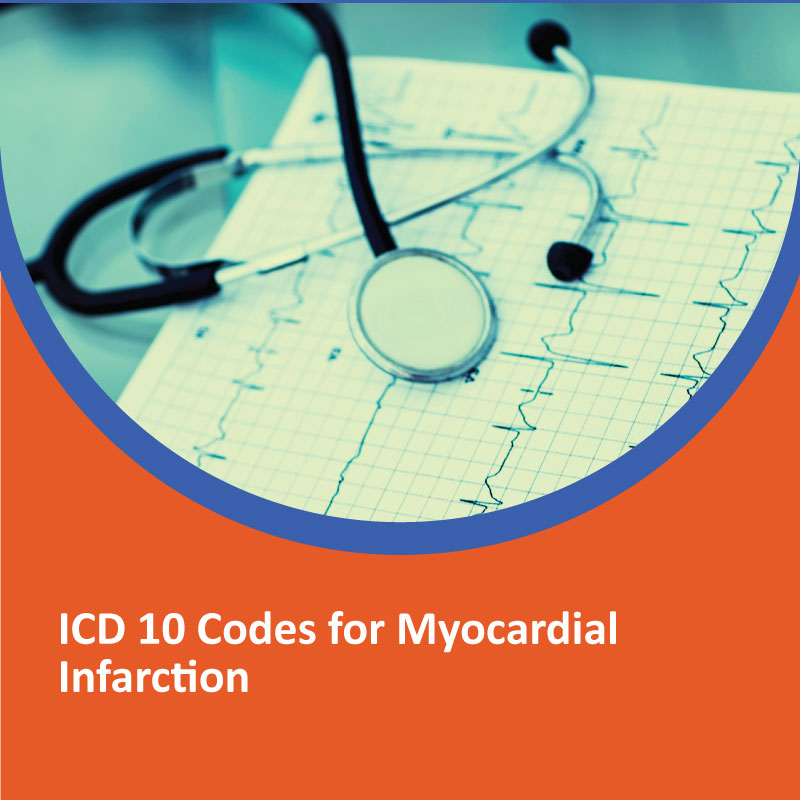Myocardial Infarction is commonly known as a heart attack. It occurs when the blood flow to a part of the heart is blocked for an extended period. It is leading to damage or death of the heart muscle cells. Myocardial infarction is a severe medical emergency and a leading cause of death worldwide.
In healthcare, the ICD-10 coding system is super important. It helps standardize how diseases, like heart attacks, are classified and coded. It’s like a universal language for healthcare folks, insurance people, and policymakers. It makes it easier to keep records straight, deal with bills, and do research accurately.
This article provides an overview of ICD 10 codes for myocardial infarction and related to different types of MI. Doctors really need to understand these codes. It helps them keep records right and report heart attack cases accurately. Plus, it ensures patients get the right treatment and get paid for it. And for researchers, it’s key to look at trends in heart attacks and what happens afterwards.
Understanding ICD 10 Codes for Myocardial Infarction
The heart acts like two muscular pumps. It circulates blood throughout the body to supply oxygen and nutrients to tissues and organs. Also, it is ensuring they work properly. Inside, it’s divided into four chambers. They are the upper atriums and the lower ventricles. The right side gathers deoxygenated blood from the body and sends it to the lungs for oxygenation. On the other hand, the left side pumps oxygen-rich blood to the rest of the body via the left ventricle.
Heart attacks are also called myocardial infarctions. It happens when one or more arteries that carry oxygen-rich blood to the heart muscle suddenly get blocked. This blockage stops enough oxygen from reaching the heart tissue. Thus, it can lead to damage or even death in those areas. Heart attacks often occur when plaque in the arteries breaks open and forms clots. It blocks blood flow and deprives the heart muscle of oxygen.
There are different types of heart attacks. It includes ST-segment elevation MI and non-ST segment elevation MI. STEMI occurs when a coronary artery is completely blocked. It causes significant damage to the heart muscle and noticeable changes on an electrocardiogram. On the other hand, NSTEMI happens when only part of an artery is blocked. It results in less severe damage and different ECG findings.
Symptoms of a heart attack can vary but commonly include chest pain that spreads to the arms, and back. It also includes neck, jaw, or stomach, along with shortness of breath, nausea, vomiting, sweating, dizziness, and palpitations. Early treatment and recognition are crucial to prevent complications. It is also important to minimize damage to the heart muscle. If you suspect someone is having a heart attack, it’s essential they seek immediate medical help.
The ICD 10, or International Classification of Diseases, Tenth Revision, is a globally recognized system. It is used to categorize diseases and injuries. It is made up of codes comprising letters and numbers, organized into chapters, sections, blocks, and categories for easy use. This classification system helps classify health conditions effectively worldwide.
Key ICD 10 Codes for Myocardial Infarction
I20: Angina Pectoris
Angina pectoris refers to chest pain or discomfort. It is caused by reduced blood flow to the heart muscles. There are different types:
Stable Angina: Typically triggered by physical exertion or emotional stress, stable angina follows a predictable pattern and is relieved by rest or medication. ICD-10 code: I20.0 – Stable angina pectoris.
Unstable Angina: This type of angina occurs unpredictably, even at rest, and may indicate a more severe underlying condition, such as a heart attack. ICD-10 code: I20.1 – Unstable angina.
Variant (Prinzmetal’s) Angina: Variant angina occurs due to coronary artery spasm, often during rest rather than exertion. ICD-10 code: I20.8 – Other forms of angina pectoris.
Microvascular Angina: This type involves chest pain caused by abnormalities in the small blood vessels of the heart. ICD-10 code: I20.9 – Angina pectoris, unspecified.
I21: Acute Myocardial Infarction (AMI)
Acute myocardial infarction icd 10 is commonly known as a heart attack. Unlike angina, AMI involves the death of heart muscle cells due to a prolonged lack of oxygen. In ICD-10 coding, “acute” refers to a sudden onset or rapid progression of symptoms, emphasizing the urgency of medical attention.
ICD-10 codes for AMI include:
- I21.0 – Acute transmural myocardial infarction of the anterior wall: This code specifies a heart attack affecting the front wall of the heart’s left ventricle.
- I21.1 – Acute transmural myocardial infarction of the inferior wall: This code indicates a heart attack affecting the bottom wall of the left ventricle.
- I21.2 – Acute transmural myocardial infarction of other sites: This code is used for heart attacks affecting different areas of the heart’s left ventricle.
- I21.3 – Acute transmural myocardial infarction of unspecified site: When the specific location of the heart attack is unknown or unspecified.
Additional codes may specify the presence of complications, such as:
- I21.4 – Acute subendocardial myocardial infarction: This nstemi icd 10 indicates a heart attack affecting the inner layer of the heart muscle.
- I21.9 – Acute myocardial infarction, unspecified: When the specific type or location of the heart attack is not documented.
By using these specific ICD 10 Codes for Myocardial Infarction, healthcare providers can accurately document the type and severity of myocardial infarction, enabling appropriate treatment and monitoring.
Using ICD-10 Codes for Myocardial Infarction Effectively
Accurate coding of myocardial infarctions using ICD 10 codes is crucial for getting paid. Also, for analyzing healthcare data. When coding is done right, it helps track cases accurately. It supports efforts to improve quality in healthcare.
Healthcare providers have a bunch of tools to help with this. It is like the ICD 10 CM codebook, online databases, and electronic health record systems. These resources make it easy for providers to find the right codes for MIs and other conditions. They give detailed descriptions and guidelines to help pick the best codes.
Keeping up with the guidelines for ICD 10 Codes for Myocardial Infarction is really important to code accurately and meet regulations. Providers can do this through regular training and continuing education. They can also do this by staying updated on any changes or revisions. By following the best practices in ICD 10 coding, they can get the most money back. Also, they can make sure their data is right and give better care to patients.
Conclusion of ICD 10 Codes for Myocardial Infarction
Using ICD-10 Codes for Myocardial Infarction for heart attacks is super important for doctors. By getting the codes right, they make sure they get paid properly, help with research, and make sure patients get the right care. This article is all about understanding those codes for different types of heart attacks, so doctors can keep records accurate and report any big heart events correctly.



